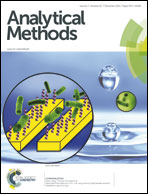Green, fast and selective preconcentration of lead ions from various matrices using a novel magnetic sheet-like resin
Abstract
In this study, an environmentally friendly method has been developed to carry out the fast and selective preconcentration of trace lead ions from water and food samples. For this purpose, a solvent-free route has been employed to prepare Fe3O4 and magnetic citric acid–ascorbic acid based resin through mixing the solid reagents. The prepared composite has been characterized with FE-SEM, TEM, FT-IR, VSM, XRD and TGA techniques. The characterization results revealed that the material has a sheet structure and the magnetic nanoparticles are well dispersed on the resin matrix. It was found that the adsorption was very fast as equilibrium was obtained within one min. The selectivity of the sorbent was examined by comparing the behavior of the sorbent for the adsorption of divalent copper, lead, cadmium, cobalt, and zinc from aqueous solutions; the relative selectivity factor (αr) of Pb2+ with respect to the aforementioned cations was 2.45, 3.61, 4.1, and 4.62, respectively. The adsorbed lead ions were stripped from the sorbent using 5 mL of 2 mol L−1 hydrochloric acid. The adsorption data was measured at room temperature and yielded a monolayer capacity of 1000 mg g−1. The limit of detection (LOD) and the relative standard deviation were 0.32 μg L−1 and 2.85% (n = 6, concentration = 0.1 mg L−1), respectively. Thermodynamic studies reveal that the lead adsorption was spontaneous, which follow an endothermic path with an increase in entropy.


 Please wait while we load your content...
Please wait while we load your content...